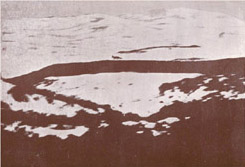
Wild
fox
running
on
a
wall
top
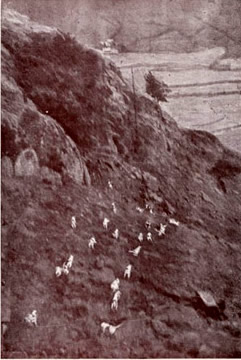
Eskdale
&
Ennerdale
foxhounds
in
full
cry
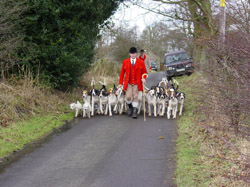
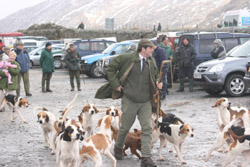
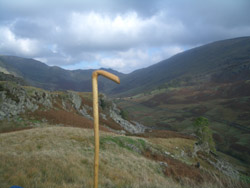
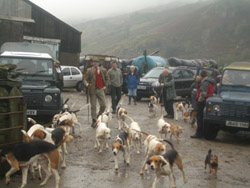
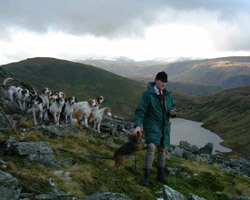
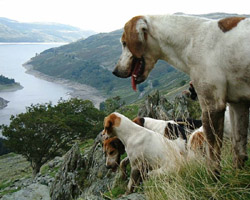
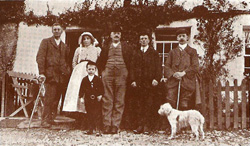
Mr
&
Mrs
Joe
Bowman
at
their
cottage
in
Grisedale
with
Messrs
B
Black,
A
S
Dixon,
W
Graham
(Ambleside),
and
grandson
Master
Lawrence.
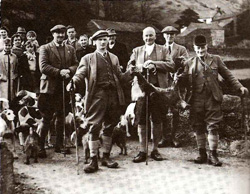
Ullswater
Hounds,
with
Huntsman
Joe
Weir
and
Whipper-In
G
Black
holding
fox.
This is simply a brief history of hunting in Lakeland - it is no substitute for any of the books written on the subject (see Bibliography).
Part One
In the 18th century, there was a custom known as 'Foresters Corn' by which the bailiff kept dogs for the hunting and destroying foxes and other "vermin".
In the neighbourhood of Patterdale he received 40 quarts of oats from every tenant for this service. For some reason the bailiff refused to keep the dogs any longer. With no dogs being kept the 'vermin' multiplied as did reports of lamb worrying. A meeting was held in the local vestry where it was decided to raise money to hire a man to destroy the "vermin". But before this was accomplished the churchwarden paid out of his funds a bounty on the head of dead "vermin" at the following rates.
For killing a fox 10 groats
For killing a fox cub 3 groats
For killing an eagle 3 groats
For killing a wild cat 2 groats
The parishioners acquired the swiftest foxhounds and hired "skilful sportsmen" with guns and "every other engine of destruction". Skelton (Reminiscences of Joe Bowman, published 1921) recorded the outcome.
"Whitsun-week 1759 was fixed for the attack, and within the first week 12 foxes were destroyed. The campaign yielded 15 foxes, seven badgers, 12 wild cats, and a large number of eagles and ravens etc." (RJB page 109)
Parochial records show that the payment from church funds for the slaughter of foxes and other animals and birds viewed as pests continued for many years. In fact, I believe Borrowdale kept a rope in the valley specially for use on eagles nests.
JPN Watson in his autobiography Blue and Scarlet published in 1990 quotes Hutchinson writing in 1794 about the inhabitants of Loweswater.
"The people here live in harmony and they express contentment. The peasantry have one enjoyment here, which is prohibited to most men of their class. Through the liberality of their lords a hound is kept in nearly every house. Two or three qualified inhabitants take licence to kill game and command the pack. As soon as the harvest is in, an honest cobbler shifts his garb and becomes huntsman, and every second or third morning collects the dogs and calls the sportsmen to the field. The cottagers climb the mountainside where they can view the chase, and without much exertion enjoy the pleasures of the hunt, after which they retire with cheerful minds and invigorated constitutions to their peaceful homes." (Blue & Scarlet, p. 158)
These circumstances led to the formation of the trencher-fed packs (ie. one where hounds are looked after by individuals and are brought together on a hunting day), which preceded the present packs.
These became the fell packs starting with the Coniston in 1825.
Part Two
With the formation of the more 'organised' packs hunting changed, but not all that much. Hounds were kept in kennel during the hunting season and in the summer months walked by local supporters (this is the practice today). The 'cobbler' who hunted hounds as referred to in the preceding chapter was replaced by a full time huntsman who usually had another man to help him. He was known as the whipper-in and his job besides helping with the kennel work was, when the hounds 'lowsed' (loosed), to get onto the high ground as quickly as possible and see which way the hunt went. As can be imagined these men soon became very fit! One of the most famous was B Wilson of the Ullswater who was known as 'the flying whip'. The lakes were divided into areas, each one hunted by a different pack.
Life was hard, there was no transport, so hounds and huntsmen walked to and from the meet. If they were in an area miles from the kennel they went for a number of days, walking there and back at the end of the week, hounds being put up in the barn and the huntsmen with the farmer. Fallen stock was collected by horse and cart and taken to the kennels where it was boiled up with meal to produce a porridge.
An ongoing problem with many hunts was finance, the wages were very low and only paid during the season. In summer hunt staff were laid off and had to seek alternative employment, i.e. farm labourer or shepherd. Expenditure was kept as low as possible. Veterinary medicine was limited and expensive and a huntsman needed to have a basic knowledge of diagnosis and treatment using the primitive medicine(s) available.
From records available it would appear that the Fell packs killed few foxes during the 19th century, and an increased number at the start of the 20th. Not all packs were as fortunate however. In Baily's hunting Directory 1902-1903 the Coniston reported (p. 5) hunting 41 days from which they found 26 foxes, killed 10, holed 6 and 1 banked in a dangerous crag. The following year the Blencathra reported (p. 2) killing 67 foxes. The author added (p. 3), "It has been the worst season the Hon Sec has known for foxes stealing and killing lambs in Wythburn, Borrowdale, Newlands and several other parts of our area. A mangy fox has never been seen in this district, save one and no doubt it came from the south."
During the season 1903-04 whilst the Blencathra accounted for 67 foxes that season, the Coniston hunted 37 days and reported (p. 6), "killed perhaps half a dozen foxes. No mange so far known, the worst season so far known".
By 1904-1905 the Blencathra recorded 82 foxes but reported mange had made an appearance, "the mangy foxes seen did not look like foxes bred in this country".
This was the beginning of the end of the 'traditional quarry' the Greyhound fox, as its smaller cousins moved into the lakes from the surrounding areas. By 1915 they had almost gone, a sighting being worthy of note.
Finance was still a problem. Unlike the mounted hunts of the south, the followers could not afford much in the way of subscription, and the trappings of the chase (hunt buttons, etc.), were non-existent. One way of raising revenue was the 'hunt supper' or 'tatie pot' where a meal was provided accompanied by much drinking and singing. These are/were a good source of income, which brought the village and community together. Today some hunts also have 'Race Nights' as well.
As time went by, things slowly began to improve at the kennels. Electric light appeared doing away with the old tallow candles, sheds were built for butchering fallen stock (previously done in the open!).
A van was purchased to transport the hounds, veterinary medicine improved. The huntsman became usually a one-man operation, some hunts doing away with the whipper-in.
Finally 'The Ban' appeared changing hunting possibly forever.